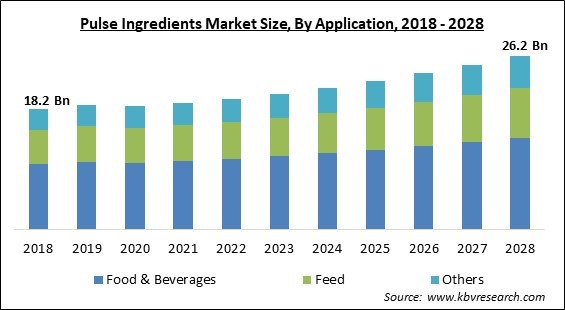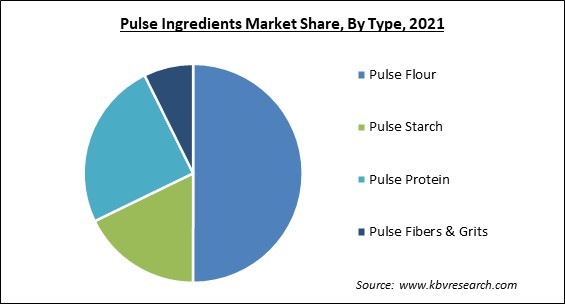The Global Pulse Ingredients Market size is expected to reach $26.2 billion by 2028, rising at a market growth of 4.9% CAGR during the forecast period.
Edible seeds of plants in the legume family are known as pulses. Pulses are produced in a variety of shaped, sized, and coloured pods. These are low in fat and have a high protein and soluble fibre content. Additionally, it helps to lower cholesterol and regulate blood sugar levels. Ingredients from pulses are rich in vitamins and healthy minerals such as iron, zinc, and magnesium. Peas, lentils and chickpeas are examples of pulse foods.

Ingredients from pulses are utilized in a wide range of food products, such as soups, sauces, baked goods, meals, snacks, and confections. It is available in many different forms, such as protein, flour, and fibre. The main drivers of market expansion are the rising demand for products that are plant-based and gluten-free as well as the rising popularity of foods that are high in protein. A change in people's lifestyles and rising disposable money are anticipated to have a positive impact on the Pulse Ingredients Market's overall market growth.
Pulse components, especially pulse flour, are highly sought after because they provide a variety of proteins, iron, and fibres. Along with other things, pulse flour could be utilized to prepare pasta, pudding, and cookies. The market for pulse ingredients would expand as a result of growing applications for pulse flour in a number of sectors, including beverage, food, and animal feed, including products made with pulse ingredients for dog food.
Ingredients for pulses can be found as concentrates with between 55 and 60 percent protein or as flours ranging from fine to coarse made from peas, lentils, fava beans, or chickpeas. Non-GMO, gluten-free, abundant in protein, lysine, dietary fibre, and minerals, pulse components also have a low glycemic index. Emulsification, gelation, texture, water-holding, adhesion, and film formation are all provided by pulse components. They could be added to formulas to boost the protein content or to eliminate or reduce other proteins. They enhance moisture and texture when used with other gluten-free flours.
The food supply system has been devastated by the advent of new coronaviruses and the ensuing tight restrictions. The world's demand for components derived from pulses has dropped as a result of the closure or scaling back of the food service sector. On the other hand, sales of processed meals such snacks, breakfast cereals, bakery and confectionery, and functional beverages rose over this period, partially offsetting the decline in the foodservice sector. Ingredients from pulses have also been widely employed in processed foods. Pulse ingredients are predicted to expand both during and following the pandemic due to the industry's resilience in the face of the disease.
Pulse starch can be used to gel, texturize, bind, coat, thicken, and make films, among other things. It has been utilized in a variety of food applications, including pasta and noodles, pastry, soups & sauces, confectionery, and meat & poultry because of its multifunctionality. Additionally, it is frequently used as a binding agent in the production of vermicelli. Due to its affordability and variety of uses, pulse starch is also a possible alternative for those other starches in beverage and food applications.
The rise in demand for comfort and ready-to-eat foods has been influenced by several factors, including the growing number of working women and nuclear families, an increased standard of living, and changing lifestyles. The market for RTE & bakery items, soups, and snacks made from pulse ingredients is driven by the growing desire for snacks. Busier lives have boosted the need for on-the-go products to decrease the time spent preparing meals. Demand for healthier products with pulse components also rises as a result of increasing demand for these products.
Even if the use of pulse components in cuisine is growing, there is always a critical requirement to change the flavour of these nutrients. Since chickpea flour has a distinct flavour, it should not be used in baked goods like biscotti or sugar cookies. On the other side, pea flour doesn't impart flavour to baked goods. Pulses have an off flavour that is both naturally occurring and created through the harvesting, processing, and storing processes. Aldehydes, alcohols, acids, ketones, pyrazines, and derivatives of sulphur are among the substances that give some kinds of pulse components their off-flavor. The market for pulse ingredients is predicted to grow slowly due to consumer perceptions of pulses' bitter flavour.
On the basis of type, the pulse ingredients market is segmented into Pulse Flour, Pulse Starch, Pulse Protein and Pulse Fibers & Grits. The pulse flours segment acquired the highest revenue share in the pulse ingredients market in 2021. In India and the Middle East, pulse flours made from peas as well as chickpeas had long been favoured. Pulse flours are utilized in a wide range of food products, include drinks, sauces, bakery goods, meat products, dairy products, and confectioneries. Due to the numerous health advantages they offer, both consumers and manufacturers throughout the world are becoming interested in them.

Based on source, the pulse ingredients market is divided into Lentils, Peas, Chickpeas and Beans. The peas segment garnered a significant revenue share in the pulse ingredients market in 2021. Peas are rich in minerals like phosphorus, iron, magnesium, and zinc, which promote general health. They are also well-known to help lower cholesterol and maintain blood sugar levels due to their high fibre content. Different products, including bread, snacks, soups and sauces, confectionery, pasta & noodles, and dairy, use pea-derived ingredients as key components, like pea proteins, pea starches, and pea flours.
By application, the pulse ingredients market is classified into Food & Beverages, Feed and Others. The food & beverages segment procured the highest revenue share in the pulse ingredients market in 2021. Pulses can be used to increase protein content and substitute wheat flours in gluten-free compositions for pasta, baked snacks, and baked goods. For instance, pulse protein concentrates could be utilized to increase protein content and substitute up to 20% of the wheat flour in bakery formulations. The texture, volume, and flavour of bread made with pulse protein concentrates & flours should be improved using the sponge-dough technique.
| Report Attribute | Details |
|---|---|
| Market size value in 2021 | USD 19.1 Billion |
| Market size forecast in 2028 | USD 26.2 Billion |
| Base Year | 2021 |
| Historical Period | 2018 to 2020 |
| Forecast Period | 2022 to 2028 |
| Revenue Growth Rate | CAGR of 4.9% from 2022 to 2028 |
| Number of Pages | 209 |
| Number of Tables | 370 |
| Report coverage | Market Trends, Revenue Estimation and Forecast, Segmentation Analysis, Regional and Country Breakdown, Companies Strategic Developments, Company Profiling |
| Segments covered | Type, Source, Application, Region |
| Country scope | US, Canada, Mexico, Germany, UK, France, Russia, Spain, Italy, China, Japan, India, South Korea, Singapore, Malaysia, Brazil, Argentina, UAE, Saudi Arabia, South Africa, Nigeria |
| Growth Drivers |
|
| Restraints |
|
Region-wise, the pulse ingredients market is analyzed across North America, Europe, Asia Pacific and LAMEA. A possible market for pulse components is Japan, which has a sizable elderly population. This is anticipated to increase demand for food products with added protein, which will increase demand for pulse components. Due to its vast population and movement toward plant-based components, the Asia Pacific area is predicted to have a significant demand for pulse ingredients in the upcoming years.
Free Valuable Insights: Global Pulse Ingredients Market size to reach USD 26.2 Billion by 2028
The market research report covers the analysis of key stake holders of the market. Key companies profiled in the report include Tetra Laval International S.A. (Delaval), GEA Group AG, Archer Daniels Midland Company , Ingredion, Incorporated, Batory Foods, Inc., Roquette Freres SA, The Scoular Company, Axiom Foods, Inc., Emsland Group and Dakota Dry Bean, Inc. (Dakota Ingredients).
By Type
By Source
By Application
By Geography
The Pulse Ingredients Market size is projected to reach USD 26.2 billion by 2028.
Growing demand for pulse starch in numerous food and industrial usage are driving the market in coming years, however, Flavour of pulse ingredients are unpleasant restraints the growth of the market.
Tetra Laval International S.A. (Delaval), GEA Group AG, Archer Daniels Midland Company , Ingredion, Incorporated, Batory Foods, Inc., Roquette Freres SA, The Scoular Company, Axiom Foods, Inc., Emsland Group and Dakota Dry Bean, Inc. (Dakota Ingredients).
The expected CAGR of the Pulse Ingredients Market is 4.9% from 2022 to 2028.
The Chickpeas market dominated the Global Pulse Ingredients Market by Source in 2021; thereby, achieving a market value of $8.7 billion by 2028.
The Asia Pacific market dominated the Global Pulse Ingredients Market by Region in 2021; thereby, achieving a market value of $6.1 billion by 2028.
Our team of dedicated experts can provide you with attractive expansion opportunities for your business.

